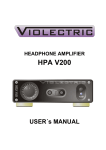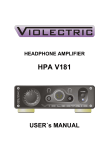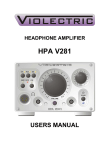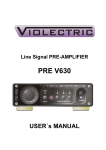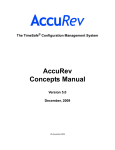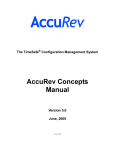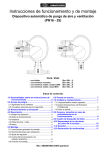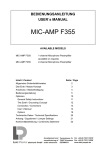Download Violectric PPA V600 User`s manual
Transcript
PHONO PRE-AMPLIFIER PPA V600 USER´s MANUAL 1 Content Theme Page About Violectric Safety Instructions The Earth / Grounding Concept Connection / Connectors General Operation Input Impedances Input Capacities Setting the Equalizer Opening the Case / Dismantling Things to know Disposal Technical Data Jumper Setting Conformity Statement Warranty 2 3 5 7 9 10 11 15 16 17 20 21 24 25 26 27 28 Cordial thanks for your decision in favour of a product ! is a trademark and product line of Lake People electronic GmbH. Lake People electronic GmbH develops, manufactures and distributes products in the professional range, for broadcast, television, airports, exhibition halls, festival venues, theatres, large-scale installations, private studios and more. In the private sector as well, Lake People products become increasingly popular due to their outstanding quality. The trademark and product line is specially intended to supply the Hi-Fi and High-End market with its specific requirements. Who develops equipment ? devices are exclusively developed in Germany by the engineers of Lake People electronic GmbH. In doing so, the team of developers can draw on twenty years of experience and countless products for the pro-audio domain. Among others, the first German-made 20-bit A/D and D/A converters were developed by Lake People in the early nineties of the past century. Who manufactures equipment ? devices are exclusively manufactured in Germany by Lake People electronic GmbH or contractors in the company's vicinity. - put high emphasis Lake People - and by association on domestic manufacturing. As well, all component suppliers are chosen in order achieve the main part of added value inland. 3 How do devices get to the customer ? devices can be obtained from respective specialist suppliers. If there is none such accessible regionally, the customer is supported by transregional distribution partners (google may help...) and, of course, by Lake People electronic GmbH themselves. … and if it doesn't work like it should ? devices are covered by a 24-month warranty. In case of any malfunction during this period, they can be shipped to the manufacturer directly. Of course, the client will benefit from 's and Lake People's full technical support even when warranty has expired. Any technical questions or need for advice is welcome. is a subsidiary of LAKE PEOPLE electronic GmbH Turmstrasse 7a D-78467 Konstanz Fon +49 (0) 7531 73678 Fax +49 (0) 7531 74998 www.violectric.de www.lake-people.de www.violectric.com www.lake-people.com 4 General Safety Instructions WARNING For your protection, please read the following: Water, Liquids, Moisture: This appliance should not be used near water or other sources of liquids. Care should be taken so that objects do not fall and liquids are not spilled into the enclosure through openings. Power Sources: The appliance should be connected to a power supply only of the type described in the operating instructions or as marked on the appliance. Grounding: Care should be taken that this appliance is operated with proper grounding only. Power Cord: Power supply cords should be routed so that they are not likely to be walked on or pinched by items placed upon or against them, paying particular attention to cords at plugs, convenience receptacles, and the point where they exit from the appliance. This unit is equipped with a 3-pole mains cable with German 3-pin mains plug. In some countries this unit must be operated with a mains adaptor, supplied by the owner. Please refer to the table below to connect a mains plug: OVERVIEW: POWER CORD FUNCTION AND COLORS CONDUCTOR L N E LIVE COLOR Alternativ BROWN BLACK NEUTRAL BLUE WHITE PROTECTIVE EARTH GREEN+YELLOW GREEN U.K. Mains Plug Warning: A moulded mains plug that has been cut off from the cord is unsafe. Discard the mains plug at a suitable disposal facility. NEVER UNDER ANY CIRCUMSTANCES SHOULD YOU INSERT A DAMAGED OR CUT MAINS PLUG INTO A 13 AMP POWER SOCKET. Do not use the mains plug without the fuse cover in place. Replacement fuse covers can be obtained from your local retailer. Replacement fuses are 13 amps and MUST be ASTA approved to BS 1362. 5 Mains Fuse: The mains fuse of this appliance is soldered in place and accessible from the inside only!! A blown fuse may indicate an internal problem and should be replaced during qualified servicing or repair work !! Power Supply: Connect this unit to the power source indicated on the equipment rear panel only to ensure safe operation !! This unit is provided with a multi-mode switch-mode supply and accepts mains voltages from 90 … 250 V AC and thus is suitable for glueless worldwide operation. Service / Repair: To reduce the risk of fire or electric shock, the user should not attempt to service the appliance beyond the measures described in the operating manual. All other servicing or repair should be referred to qualified personnel !! VOR DEM ÖFFNEN NETZSTECKER ZIEHEN!! PULL MAINS BEFORE OPENING!! AVANT D´OUVRIER RETIREZ LA FICHE MALE!! Electromagnetic Compatibility This unit conforms to the Product Specifications noted as Declaration of Conformity at the end of this manual. Operation is subject to the following conditions: - this device may not cause harmful interferences - this device must accept any interference received, including interference that may cause undesired operation - this device must not be operated within significant electromagnetic field 6 The Earth / Grounding Concept General GROUND-LIFT Jumper (accessible from the inside. Mind the SECURITY INSTRUCTIONS !! ): Ex-works this jumper is set to the LIFT position. The internal ground potential is “lifted” by means of this jumper. As a result, the interconnection for DC voltages and lower frequencies (< 150 Hz) will be cut. Higher frequencies will be bled off to earth potential through the RC filter. The LIFT position is helpful in case of hum or jitter caused by different ground/earth potentials. Of coarse full electrical protection is garanteed as the case is always connected to ground/earth potential! See also: page 20 / 26, Technical Appendix. 7 Unfortunately there is no general recommendation how to solve hum and jitter problems - or even minimize them. The best way to succeed is to check different options !! In case of balanced cables, it should always been verified if the shield of the cable is connected to the shell of the XLR connector. The shell is ALWAYS connected to earth potential when the connector is inserted !! Concerning ANALOG inputs and outputs, the relationship between ground and earth may be modified. Electrical safety is always ensured, since the earth conductor is permanently connected to the enclosure !! XLR GROUD-LIFT Jumper (accessible from the inside. Mind the SECURITY INSTRUCTIONS !! ): G(ROUND): Ex-works all jumpers are set to "G" (ground) position. Pin 1 is connected to the internal ground reference. High frequency interference is deflected to the case via a 100 nF capacitor. L(IFT): The interconnection between Pin 1 and ground is open. High frequency interference is deflected to the case via a 100 nF capacitor. This jumper position is specifically useful if the unit is equipped with transformers !! C(ASE): Pin 1 is connected to the case, the 100 nF capacitor is bridged. This jumper position may be varied together with the General GROUND-LIFT jumper. See also: page 20 / 26, Technical Appendix. Please note that with jumpers not in the ex-works position EMC emission might occur, for which the user is responsible only ! 8 Connection / Connectors for analog signals 9 GENERAL INFORMATION The PPA V600 is a high-quality, two-channel preamplifier for movingcoil and moving-magnet pickup systems. Its groundbreaking design allows a variety of setting possibilities second to none. Due to the implementation of professional instrumentation amplifiers in the input section, it offers extraordinarily low noise figures and extreme bandwidth even at high gain. Features: - balanced inputs via gold-plated Neutrik 5-pin XLR sockets - unbalanced inputs via gold-plated cinch sockets - input impedance internally switchable, 9 settings - input capacitance internally switchable, 16 settings - low-noise instrumentation amplifier of extreme bandwidth - front-switchable gain, in six steps from +36 to +60 dB - front-face balance control +/- 2 dB - internally selectable equalization: RIAA / NAB / BBC / FLAT - internally switchable 20Hz high-pass according to IEC specifications - individual-channel layout - DC-coupled signal path - top-grade operational amplifiers within the signal path - high-quality MKP capacitors within the signal path - 0.1 and 1% metal film resistors exclusively - <0.05 dB aberration from RIAA curve due to eight reference points - unbalanced outputs via gold-plated cinch sockets - balanced outputs via gold-plated Neutrik XLR connectors - lowest-noise and lowest-ripple switched-mode supply combined with and precision linear-regulated powering - internally switchable ground lift - rugged aluminium case with Nextel coating - solid aluminium laser-engraved front panel 10 THE CASE The PPA V600's case as well as the front/rear panels are made of solid aluminium. This choice of material ensures high mechanical stability and resistance. EARTH AND GROUND The PPA V600's case is grounded. Internal reference ground is bridged to protective earth by means of a jumper. The jumper is set to the 'LIFT' position (see also: page 7 "Earth/Ground concept" and pages 20/26 "Technical Appendix"). POWER SUPPLY Mains power is provided via a three-pin IEC/CEE socket and mating "cold-appliance" mains cord with Schuko-type plug. Because of the employed multi-mode switch-mode supply the actual AC voltage may vary between 90 and 250 volts AC for flawless operation. The US and Japan version comes with a US style mains cord. Bith switch-mode supplies will output 24 V DC. External filters will cut any high frequency glitches. Line regulators form the internal operating voltages of +/-18 V. MAINS FUSE The 0.25A time-lag fuse is soldered in place on the circuit board. In case, it must be replaced with a fuse of the same type only. CAUTION !! MIND THE SAFETY INSTRUCTIONS: A blown fuse indicates an internal fault and should be replaced during qualified repair or servicing only !! 11 THE BALANCED SIGNAL INPUT For the connection of balanced signals a gold-plated 5-pin XLR socket is located in the 'cartridge input' section on the rear of the unit, denoted as 'BAL'. 5-pin XLR Pin-Out: PIN 1 Left (+) PHASE PIN 2 Left (-) PHASE PIN 3 Ground PIN 4 Right (-) PHASE PIN 5 Right (+) PHASE THE UNBALANCED INPUTS Or the connection of unbalanced signals two gold-plated cinch sockets are located in the 'cartridge input' section, denoted as 'UNBAL L' and 'UNBAL R'. INPUT SELECTION The cinch inputs sockets are activated ex-works. In order to utilize the balanced inputs, the unit must be opened and the two related jumpers set from 'U' (unbalanced) to 'B' (balanced). See also: technical appendix page 20 / 26. 12 OPERATION The following controls and displays are located on the front panel: POWER SWITCH The unit is turned on by means of the power switch. The blue LED beneath the switch indicates that the unit is ready for operation. GAIN SWITCH The gain switch on the front panel allows easy signal gain control, offering six possible settings: 30 / 36 / 42 / 48 / 54 and 60 dB. Gain is set for both channels individually by means of a precision resistor array, thus offering highly accurate stereo matching at lowest crosstalk. Settings of 30...42 dB are usually suited for MM systems, while 48...60 dB are intended for the use with MC pickups. So-called 'high output MC' systems are best operated at 42...48 dB gain. As noise level rises proportional to gain, it is always recommended to choose the lowest practical gain setting ! BALANCE CONTROL By technical means, pickup systems usually don't present exact channel balance, and even sophisticated systems can exhibit a channel matching error of 1...2 dB. This can lead to a shifted stereo image 13 which, however, can easily be compensated by the balance control, with an adjustment range of +/-2 dB and a detented centre position. In order to maintain minimum crosstalk, balance is set by means of fine adjustment of the right channel, instead of a conventional balance pot as found on other devices. AMPLIFIERS / INTERNAL SETTINGS The low input signals are fed to a so-called instrumentation amplifier, originally intended for the use with professional microphones. This allows extremely low-noise amplification vastly superior to any other design, while offering an internal bandwidth of >200 kHz even at 60 dB gain. Susceptibility to hum as induced by low-frequency equalization and interference to the cable between turntable and input can be significantly reduced by balanced coupling between the pickup system and the amplifier, using balanced cabling. In order to precisely match with any pickup model, 9 input impedance and 16 input capacitance settings can be selected by DIP switches inside the unit. While the RIAA equalization curve is the most commonly used, the PPA V600 can also be switched to NAB, BBC or FLAT curve. In addition, it provides a 20Hz IEC high-pass filter, which can be inserted in the signal path by DIP switches. All the filters are passive designs, using highquality and non-ageing MKP capacitors. By means of eight reference points, the RIAA curve is precisely maintained with an accuracy of 0,05 dB. Channel circuits are completely separate, in order to obtain optimum crosstalk rejection. 14 INPUT IMPEDANCE Input impedance can be precisely matched to the respective MC (moving-coil) system by means of switchable input impedance. The value matching best can either be read in the pickup's technical specifications, or optimized by further recommendations and listening tests. Settings comprise 10, 90, 100, 130, 150, 250, 330, 1k and 47k ohms, whereas 47k is recommended for MM (moving magnet) systems. The unit's case must be opened to change this setting. See also: technical appendix, pages 20 / 26. The DIP-switches marked with “MC” may be set as follows: Note: Setting ex works is 47kOhm 15 INPUT CAPACITANCE Input capacitance can be precisely matched to the respective MM (moving magnet) system by means of switchable input capacitance. The value matching best can either be read in the pickup's technical specifications, or optimized by further recommendations and listening tests. Settings comprise 33, 66, 110, 150, 180, 210, 260, 300, 330, 370, 410, 450, 480, 520, 560 and 600 pF. Input impedance for MM systems should be set to 47k ohms ! The unit's case must be opened to change this setting. See also: technical appendix, pages 20 / 26. The DIP-switches marked with “MM” may be set as follows: Note: Setting ex works is 33 pF 16 EQUALIZATION CURVES 17 EQUALIZATION CURVES Due to technical considerations, the signal stored on vinyl records has been equalized during manufacture, i.e. low frequencies are reduced and high frequencies are boosted. Upon playback in turn, an equalizer as accurate as possible is employed in order to re-linearize frequency response. There were several dozens of equalization curves in record history, but fortunately the so-called RIAA curve (Recording Industry Association of America) has established itself as the most common standard. Nevertheless, one may encounter records manufactured using NAB (National Association of Broadcasters), BBC (British Broadcasting Corporation) or FLAT (no treble EQ) equalization curves, which the V600 can easily cope with by means of its switching capabilities. Furthermore, a 20 Hz highpass or 'rumble' filter according to IEC (International Electrotechnical Commission) can be switched into circuit. See also: technical appendix, pages 20 / 26. Note: Setting ex works is RIAA 18 THE UNBALANCED OUTPUTS The unbalanced output signal is available at gold-plated cinch sockets on the rear panel. They are denoted as 'UNBAL L' for the left channel, and 'UNBAL R' for the right one respectively. Output impedance is significantly less than 1 ohm ! THE BALANCED OUTPUTS The balanced output signal is available at gold-plated XLR connectors on the rear panel. They are denoted as 'BAL L' for the left channel, and 'BAL R' for the right channel respectively. Output impedance is significantly less than 1 ohm ! Output polarity complies with AES 14-1992: 1 = ground / 2 = in phase / 3 = out of phase. NOTE: When connecting unbalanced loads to the balanced outputs, pin 3 must not be bridged to signal ground but left unconnected. Output signal level drops by 6 dB in this mode. NOTE: Unbalanced and balanced outputs shall not be used simultaneously, as the output driver feeds both the cinch socket and the in-phase pin of the balanced output at the same time. 19 OPENING THE UNIT In order to change any DIP switch or jumper settings inside the PPA V600, its case must be opened. For this purpose, a TORX screwdriver T10 is required, and you should - by all means - PULL THE MAINS PLUG !!! after which any setting procedures can be effected without risk. Disassembly 1. 2. 3. 4. 5. remove the two upper screws on the front panel loosen the two lower screws on the front panel by 2 to 3 turns remove the two upper screws on the rear panel lift off the lid to gain access to the switches/jumpers reassemble the unit in reverse order. Things to know… Why are turntables susceptible to hum ? Most turntables are connected unbalanced via cinch leads. Unfortunately indeed, since a balanced connection would be hum-free in practice and much more advisable in technical terms. Common pickup systems usually represent a perfect dipole, and thus the advantages of balanced signal connection could easily be made use of. Moreover, vinyl recordings are being equalized during the production process, i.e. low frequencies are reduced and high frequencies boosted. During playback, the equalizing preamplifier inverts this process, thus enhancing not only the low frequency range, but also any hum interference to the signal lead. When connecting the pickup in balanced mode, hum interference as would be unavoidable with unbalanced leads is significantly reduced. 20 The PPA V600 offers both balanced and unbalanced inputs. What's the advantage of a balanced signal ? In contrast to unbalanced signals, balanced signals are transmitted via two wires plus ground connection. A balanced signal is accomplished by inverting the original source signal at unaltered level. One wire carries the original, unaltered signal (a), the second wire the inverted signal (-a). At the receiving input, the signal is fed to a differential amplifier which 'sees' the difference between a and -a only, at a resulting level of 2*a. On a signal path between devices, interferences (s) may try to disturb the signal by entering the connecting line, but being in-phase with respect to both signal wires. The differential input again sees the difference between interferences on both wires only. Thus - after the rule (s) - (s) = 0 - they are eliminated almost completely. The PPA V600 uses instrumentation amplifiers. Why did we choose instrumentation amplifiers ? Like mentioned earlier, the balanced signals are fed to special instrumentation amplifiers with differential inputs, which were originally intended for the use with microphones. However, the difference between dynamic microphones and pickup systems isn't as big as one might assume: By means of wire coils and magnetism, they both deliver very low signal voltage at quite similar impedance. During design, we discovered that this breed of instrumentation amplifiers is ideally suited for turntable pickups as well. The PPA V600 has a gain control on the front panel Why is an easily accessible gain control useful ? A further advantage of instrumentation amplifiers is that gain can be adjusted by rather simple measures. Furthermore, gain control can be achieved without any significant change in bandwidth, as faced with (multi-stage) operational amplifiers. Thus, bandwidth still exceeds 200kHz at a gain setting of remarkable 60dB, equalling a level ratio of 1:1000 ! By means of the front gain controls, the PPA V600 can easily be adjusted even for less known pickup models without hassle. Adjustment is provided for both channels individually, in order not to impair crosstalk rejection. At the same time, precision resistors ensure perfect stereo matching at 0.25 dB tolerance. The PPA V600 offers balance control on the front panel Why is easily accessible balance control important ? 21 Even high-end pickup systems may exhibit a channel level aberration of up to 3 dB. This value represents the loudness difference between channels, resulting to a shifted stereo image - or centre position - during playback. The fineresolution balance control allows shifting of the perceived centre position to where it actually should be, of course with a detented neutral position. In order not to impair crosstalk rejection, balance control is achieved by fine adjustment of the right channel only. The same circuitry section is mirrored in the left channel, but without the adjustment feature. Thus, not the faintest difference between channels in terms of transit time, phase correlation, distortion and frequency response will be found. The PPA V600 offers variable input impedance What are the advantages of variable input impedance ? Considered its extremely low output voltage, the performance of a moving-coil (MC) pickup system is much influenced by the amplifier's input impedance. The PPA V600 provides eight different impedance settings, while the ninth (47k) is the standard setting for moving-magnet (MM) systems. The optimum setting is to be read from the pickup's specification sheet in the first place, but may also be refined by further recommendations or listening tests. The PPA V600 offers variable input capacitance What are the advantages of variable input capacitance ? Moving-magnet (MM) pickups with their typically high impedance are much subject to influence by the amplifier's input capacitance. For this purpose, the PPA V600 offers 16 individual input capacitance settings. The optimum setting is to be read from the pickup's specification sheet in the first place, but may also be refined by further recommendations or listening tests. The PPA V600 offers various equalization curves What makes selectable equalization curves practical ? For technical reasons, vinyl records are manufactured with an equalized frequency response, i.e. low frequencies are reduced and high frequencies are boosted. During playback, the preamplifier must invert this equalization in order to obtain the original frequency response of the contents. 22 For this purpose, the equalization curve applied during record manufacture must be known. Quite a number of equalization curves were used over the decades however, among which the 'RIAA' curve became the most widespread - named after the Recording Industry Association of America. Other equalization curves one may encounter are 'NAB' (National Association of Broadcasters) or 'BBC' (British Broadcasting Corporation), which can also be properly handled by the PPA V600 when set accordingly. Both these curves have effect on treble reproduction, just like the 'FLAT' curve which does not imply high-frequency equalization at all. Furthermore, a 20 Hz high-pass or 'rumble' filter according to IEC (International Electrotechnical Commission) can be switched into circuit. See also: diagram on page 17 ! The PPA V600 offers individual signal paths Why are individual signal paths so favourable ? Most operational amplifiers are designed as two amplifiers integrated in a single package. If the left and right channel signal are processed by the circuit at the same time, a certain mutual interference is inevitable. The adverse effects may be marginal only, but should be excluded during the design process wherever feasible. The PPA V600 contains numerous operational amplifiers Why are operational amplifiers ideal for small-signal processing ? High-end audio gear often follows a 'discrete' design, meaning that the amplifier stages are composed of single transistors. This feature is often presented as an optimizing measure, but finally the related high manufacturing effort is to be paid by the customer. Certainly an operational amplifier is made of transistors as well. Its design however offers the advantage of thermal coupling of its individual components, and ageing issues play a negligible role. Since the choice of OP-amps on the market is huge, an ideal model for any special application can be found. The PPA V600 is powered by switching-mode power supplies Why are switching-mode power supplies ideal for phono preamps ? An equalizing preamp boosts low frequencies and therefore does right the same with hum interference radiated by a mains transformer. Thus, conventional transformers are 'audible' in many cases, sadly... 23 One possible solution would be the use of a remote power supply, which of course means additional costs for the customer due to an extra device and cabling. As an equalizer preamp consumes little power at quite constant current, and short ways between current source and load generally make sense in terms of voltage decoupling, a switching-mode power supply is the most intelligent solution here. The PPA V600 contains two thereof, i.e. one for each positive and negative voltage supply. They both provide 24 volts, which are then reduced to wellbacked +/- 18 volts by linear regulators. Switching frequency ranges well beyond 100kHz, and highly sophisticated filtering between the raw-voltage supply and linear regulation avoids any switching-frequency leakage into the signal section. DISPOSAL Disposal of Old Electrical & Electronic Equipment (Applicable in the European Union and other European countries with separate collection systems) This symbol on the product or on its packaging indicates that this product shall not be treated as household waste. Instead it shall be handed over to the applicable collection point for the recycling of electrical and electronic equipment. By ensuring this product is disposed of correctly, you will help prevent potential negative consequences for the environment and human health, which could otherwise be caused by inappropriate waste handling of this product. The recycling of materials will help to conserve natural resources. For more detailed information about recycling of this product, please contact your local Civic Office, your household waste disposal service or the shop where you purchased the product. 24 TECHNICAL DATA PPA V600 All measurement RMS unwtd., 20 Hz - 20 kHz if not otherwise noted Inputs: Max. Input Voltage: Input CMRR: Input Impedance (int. switchable): Input Capacity (int. switchable): Gain (ext. switchable): Balance: Filter Laws (Values in us): Filter Deviation absolut: Filter Difference (L < > R): Phase Difference (L < > R): IEC Lo-Cut (int. switchable): Frequency Range (Flat): Noise eIN (Ri = 0 Ohm): Noise eIN (Ri = 1kOhm): THD (@ 1 kHz, Input -30 / -60 dBu): Crosstalk (L > R / R > L): Outputs: 1 x XLR female, 5-pin, balanced, 2 x Cinch, unbalanced - 7 / -37 dBu @ 30 / 60 dB Gain > 90 / > 80 dB @ 100 Hz / 15 kHz 10, 90, 100, 130, 150, 250, 330 Ohm 1 kOhm / 47 kOhm 33, 66, 110, 150, 180, 210, 260, 300, 330 370, 410, 450, 480, 520, 560, 600 pF 30, 36, 42, 48, 54, 60 dB + / - 2dB im rechten Kanal 3183, 318 / 0 (Flat), 25 (BBC), 50 (NAB), 75 (RIAA) < +/- 0,05 dB < 0,025 dB RIAA / < 0,4 dB (alle anderen) < 0,5 Degree (RIAA) 20 Hz / 6 dB pro Oktave < 3 Hz … 85 / 60 kHz @ Gain 30 / 60 dB -117 / -130 dB @ 30 / 60 dB Gain -116 / -118 dB @ 30 / 60 dB Gain -103 / -92 dB @ 30 / 60 dB Gain < -110 / < -95 dB @ 1 / 15 kHz Max. Output Voltage: Output Impedance: 2 x XLR male, 3-pin, balanced 2 x Cinch, unbalanced +23 unsym. / +29 dBu symmetrisch < 1 Ohm Supply Voltage: Case, Front, Back: Dimensions: 90 … 250 V AC max. 12 VA Aluminium 170 x 49 x 226 mm (B x H x D) 25 26 EU CONFORMITY STATEMENT: We herewith declare that the following unit Name: VIOLECTRIC PPA V600 Serial No. : -alle - is in conformity with the following EC directives: 2006/95 EG 2004/108 EG EN 60065 : 2002 Low voltage directive Electromagnetic compability Security directives for audio-, video- und similar electronic devices For verification of conformity with regard to electromagnetic compatibility the following harmonized standards are applied: EN 50081-1 : 1992 EN 50082-1 : 1992 Generic emission standard Generic immunity standard Product family standard for audio, video, audio-visual entertainment apparatus: EN 55013 : 2001 EN 55020 : 2002 EN 61000-3-2 : 2000 EN 61000-3-3 : 1995 This declaration is given under responsibility of: LAKE PEOPLE electronic GmbH Turmstrasse 7a D-78467 Konstanz Fon +49 (0) 7531 73678 Fax +49 (0) 7531 74998 Konstanz 31.08.2011 Fried Reim 27 CEO WARRENTY Since 1986 we are constructing and manufacturing sophisticated electronics for ambitious customers. Since the early beginnings we are trying hard by accompanying measures, the use of 1st choice components and multiple quality checks during production to avoid faults at large. We are quite effective in that and this is – amongst others - why we enjoy such a good reputation. Despite all accurateness faults may occure which may derogate the proper operation of your product. In this case your unit is protected by a 2-year Warranty ! Needless to say that we will care for your product even after the expiration of the warranty. If it is necessary please dispatch your item to: Lake People electronic GmbH Turmstrasse 7a D-78467 Konstanz Fon +49 (0) 7531 73678 Fax +49 (0) 7531 74998 E-Mail [email protected] Your warranty claim begins with the date of purchase, which should be denoted on your proof of purchase. In case of return do not forget to include the receipt of sales or a copy of the receipt. Please also include a short description of the fault(s). For the reshipment we need you correct address !! Care for a safe packaging. Best is to use the original packaging. Please keep in mind that we cannot accept collect freight. We will grant a quick repair and quick return of the unit. In case of a warranty repair we will reship free of charge. Please denote here the serial number and the date of purchase: Serial Number Date of Purchase 28





























